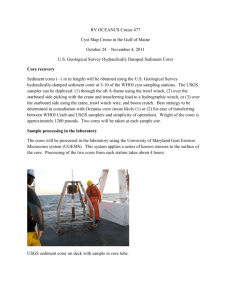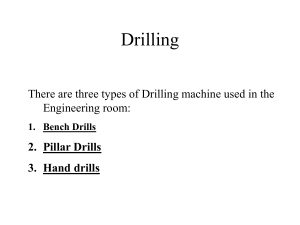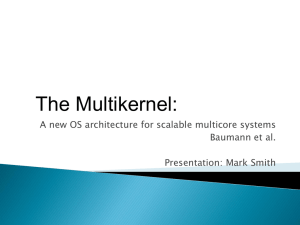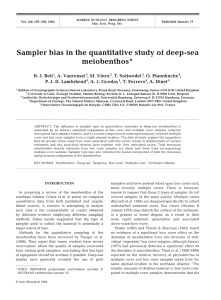321-05-Sampling-Marine-NetsGrabsCorers02
advertisement
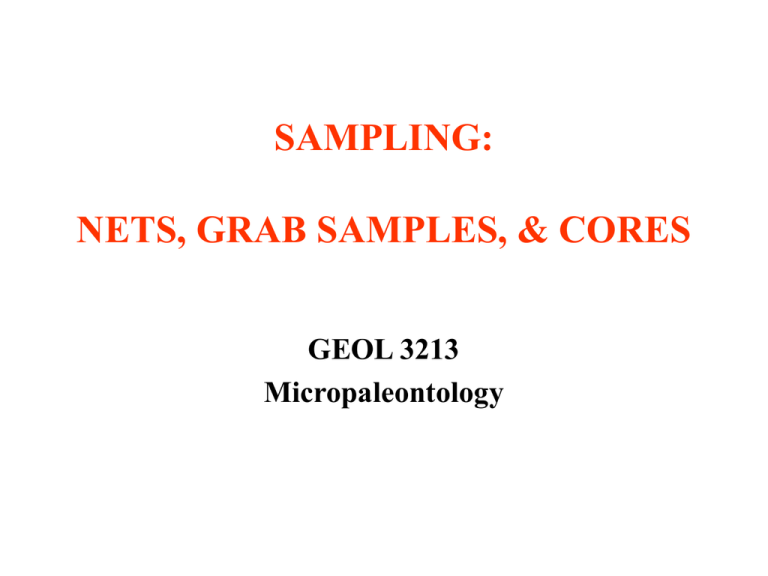
SAMPLING: NETS, GRAB SAMPLES, & CORES GEOL 3213 Micropaleontology Marine Sampling Devices • Nets • Grab samplers • Corers – Gravity corer – Piston corer • Cores – Split lengthwise (working and archival halves) – Photographed – Sampled – Stored in “core libraries” NETS • Plankton nets – Microscopic organisms – Floating (planktic or planktonic) pelagic forms – Base of the marine food web – Major groups • Phytoplankton • Zooplankton • Nets for larger organisms – Different for various depths and organisms – Coarser nets for fish – Dredges for the seafloor Bottom trawl net used on the Challenger SAMPLING MARINE SURFACE SEDIMENTS • “Grab sampler” (="clamshell sampler") – Lowered until it strikes bottom – A release mechanism then closes "cups" – Heavy enough to stay closed when raised – Covers prevent sediment from washing out as raised to surface SAMPLING MARINE SURFACE SEDIMENTS • How a Van Veen-type grab sampler works DOWN TOUCH & RELEASE CLOSE & UP GRAVITY CORER • Main components – – – – – – – – 1. Nose cone 2. Core catcher 3. Inner plastic liner 4. Steel core barrel 5. Weights (up to a ton or more) 6. Flap (on gravity corer) or piston 7. Tripping arm (on piston corer) 8. Cable to ship PISTON CORER DEPLOYING & RETRIEVING PISTON CORERS CUTTING CORE LINER • 40-foot long core liner with core is being cut – Transversely – 1.5 m lengths – Before splitting SPLIT CORE for Study • Core is cut in half – Lengthwise – Before study & sampling Turbidites deposited by turbidity currents CORE LIBRARIES • Cores are – Sectioned longitudinally – Placed in trays & photographed – Stored in hermetically sealed cold rooms. • Gulf Coast Repository (pictured here) of the Ocean Drilling Program, located at Texas A & M University, stores about 75,000 sections taken from more than 80 kilometers (50 miles) of cores recovered from the Pacific and Indian oceans. • Smaller core libraries are maintained at – Scripps – Lamont-Doherty Earth Observatory. JOIDES Resolution • • • • • (=SEDCO/BP 471) 470 ft-long and 70 ft-wide drilling ship used for the Ocean Drilling Project (ODP). Derrick towers 202' above the waterline. Computer-controlled dynamic positioning system, supported by 12 powerful thrusters and two main shafts, that maintains its position over a specific location while drilling in water depths up to 27,000'. A 12,000 sq ft, 7-story stack of laboratories and other scientific facilities occupies the areas fore and aft of the derrick. Deploys up to 30,000'of drill string. • JOIDES Resolution": the ship can deploy up to 30,000' of drill string. This view shows pipe being lowered by roughnecks. • JOIDES Resolution": roughnecks handling drill pipe with rotary drill bit. Rentry Cone • JOIDES Resolution": reentry cones are used to reenter an existing hole • End of drill string is positioned using either sonar or an underwater television system. RE-ENTRY TECHNIQUE • • • • • Computer coordinated Multiple thrusters Sonar TV cameras Funnel Cores Leave Rig Floor to the “Catwalk” • The "JOIDES Resolution": the 30-ft (9.5-m) cores are brought from the rig floor to the “catwalk,” a platform outside the laboratories where core is prepared for analysis. Sampling Working Half of Cores • JOIDES Resolution: scientists take samples from the working half of cores for both shipboard and shore-based analysis. The shipboard curatorial representative inventories all samples and enters the information into a computer. No samples are taken from the archive half. OFFSHORE OIL & GAS PLATFORMS • Drilling – Jackup – Semisubmersible On Scotian Shelf (floating) • Production – Non-floating – Floating OFFSHORE OIL & GAS PLATFORMS • Oil production platform in the North Sea END OF FILE
